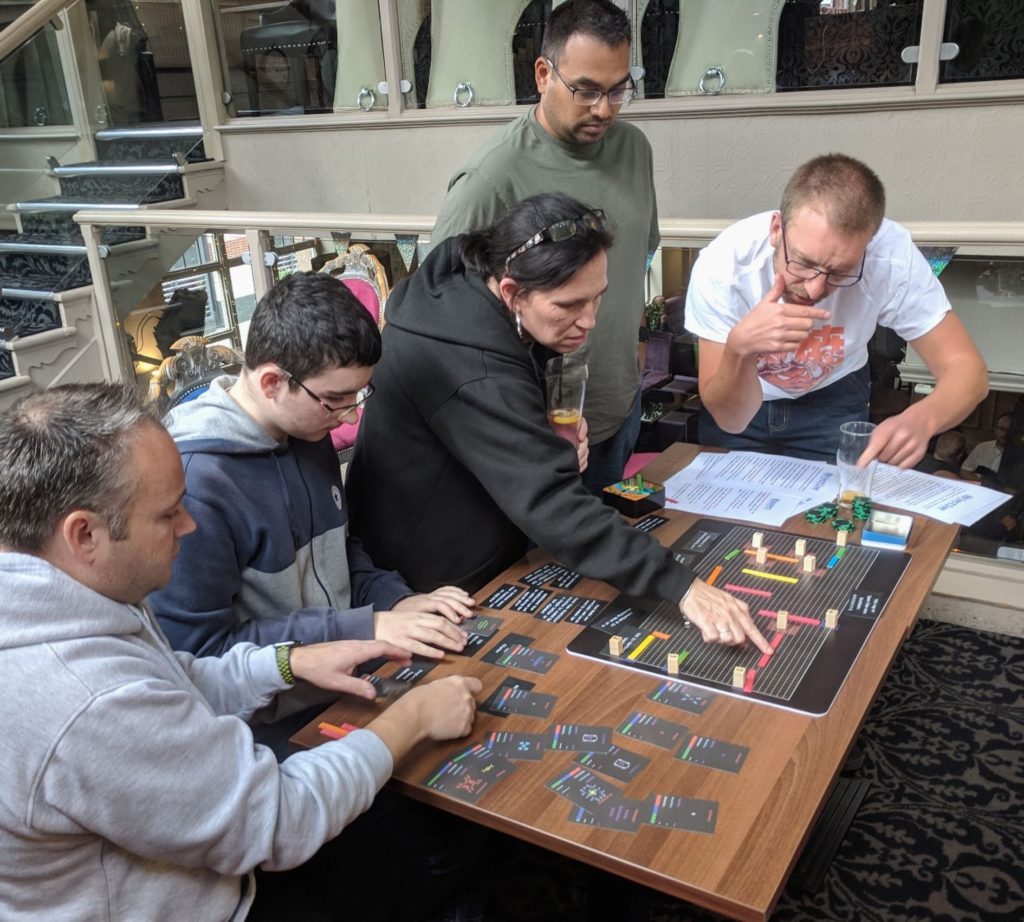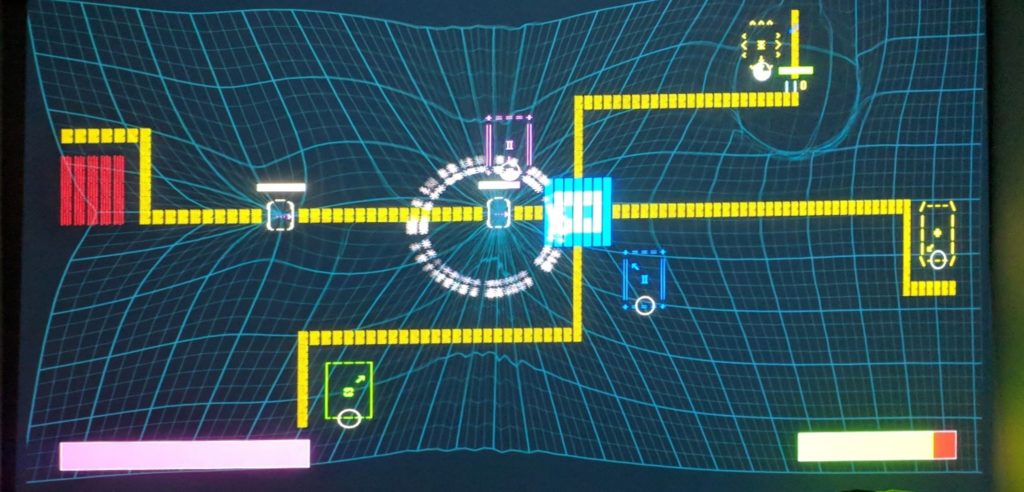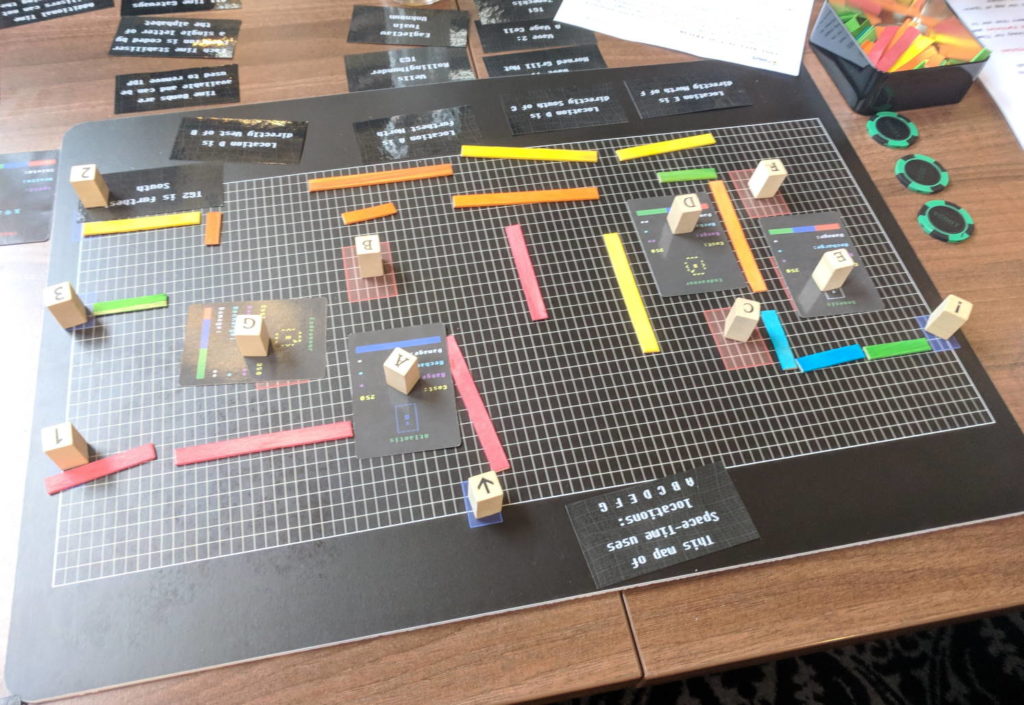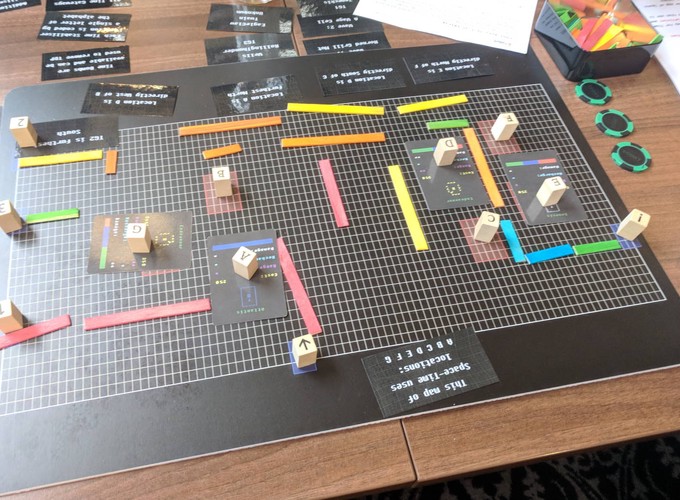This is a loooong overdue post about a collaborative, strategy game I built last summer (2018), SCOOT3. ‘Super Computer Operated Orchestrations of Time 3’ is a hybrid board game / videogame with Escape Game and Strategy elements designed to be played in teams of up to 10 and takes ~45 mins. It is one of my theories of where we might see Escape Games go next.

Brief History
For a long time I’ve wanted to build games that are hybrid digital / physical experiences, and was fortunate to meet Martyn Ruks, owner of Chronyko, builders of ‘Immersive Training’. I’d be aware of some of the amazing projects they were delivering using Escape Game / Immersive Theatre ideas but focusing the Corporate Sector.

SCOOT3 was built for Enigma – a large-scale 2.5 day immersive experience with 20+ actors and 100s of security industry challenges held at the St Pierre Marriott Country club in Wales. I’d recommend you stop reading this for a moment and have a quick watch of the unbelievable events that Chronyko have been delivering here.
With Martyn and his team and we settled on an idea that could work at Enigma but could also run after the event as a stand alone activity. In the context of the Enigma event – players are able to Time Travel to 4 different time periods. Once players reach these time periods they essentially have an Escape Room that they can explore and recover secrets from – obviously being careful not to change history. The SCOOT3 SuperComputer is able to bring these Rooms into existing by a process known as ‘Time Orchestration’. Instead of transporting players to a period in time, Time Orchestration allows objects and people from other time periods to exist temporarily here.
What is it?
SCOOT3 has been designed for a small group (5-15) of players to work collaboratively and to engage in deep strategy. I really wanted to encourage discussion, debate and theorising in a group. We see a lot of shallow, short toy-like experiences e.g. the types of games you typically find in museums and science centres. For example, where a player jumps up and down in front of a camera to make a character more on-screen. These ‘toys’ are playful but they are not deep. The players don’t really think about them too much but that is a fault of the constraints of the space. Generally we have a high thru-put of players and we can’t allow any one person to dominate a game for a long period. Players may experience dozens of interactions like this over the course of a Science Centre visit. They create good photos on social media but don’t encourage the players to think deeper.

Working with Chronyko was a fantastic opportunity to build something that allows a much richer and longer experience where players must really think about the consequences of their actions.
The Game Host
With Escape Rooms – it is typical for a Gamehost or gamesmaster to manage the experience and to ensure the level of difficulty is adjusted to the players. SCOOT3 is somewhat complicated to explain – so a game host known as the ‘Operator’ is in the room at all times to handle any questions about the rules. As with any board game – the first time you play it – understanding what it is all about is part of the problem. It’s only on the 2nd or 3rd time that you really get ‘into’ the game.
The operator smooths this process and handles all the direct interactions with the game – so players can describe what they want to do rather than worry about knowing how to use the game.
The Game Flow
It was clear from the beginning that a turn-based game would be most suitable as a real-time game would make it too much about the action and less about the strategy.
And I had been thinking of a 3-Act structure format with different objectives in each.

Observation
When building large-scale collaborative games – I often talk about multiple ‘simultaneous points of interaction’. There need to be enough simultaneous activities so that it takes more than one person to solve them. I am happy for players to initially feel overwhelmed until they can begin to see that they can share the tasks between the players. This has the advantage that no single player knows everything that is happening and encourages discussion between them.
During the observation phase there is information that needs to be gathered, analysed enabling 5 related puzzles to be solved. This information must be combined from that available on the table and that available on the screen.
At the end of this phase players can know (if they have solved all puzzles) the entire state of the world.
The puzzles are designed with increasing difficulty – while the most difficult puzzle giving you the final information. If you are unable to solve the final puzzle you are still able to have a decent go at the rest of the game.
Strategise
Now you know what is going to happen it’s time to plan your attack. Which of your resources do you wish to deploy in which area? You have a fixed amount of credits which you take to the shop to purchase your turrets (Time Stabilisers). You then choose to place these in known locations. This is the area that players are trying to optimise:
- What turrets should we buy
- What location should they be placed
The slight twist to this is that the both the good guys and the enemies can travel along the same paths. So your turrets will do damage to both good and bad guys.
This means that you have a number of different strategies to employ. This is what encourages the debate and discussion of the group:
- What is going to happen? (no one has the full information)
- What strategy do we want to adopt?
- What is the best use of our resources to act out that strategy?

Execution
At the beginning of the execution phase players read aloud the decision they have made and the operator enters these details on their behalf. There is then a reveal phase which shows the players whether they have understood the observation phase correctly.
So at this point we can watch the game play-out. Each game consists of several waves of attack which last just a couple of minutes. After each wave stronger enemies are added to the enemy pool.
In order to ensure that players are still ‘actively’ engaged in the strategy of the game – they have two additional actions:
- Between each wave – players are able to upgrade any one turret
- At any time players can deploy a targeted bomb that destroys an area of the screen (players get one bomb per wave – and these can be saved for later)
Mini Post-mortem
Ultimately this game was built in just two months. Really 3-4 months of work went into this so it was a very busy period. It was always going to be shown at a particular event – so it had to be ready and it had to work flawlessly. Ultimately, I was delighted with the final outcome and the game worked exactly as planned throughout its run at the event.
Players got incredibly engaged with the experience. I was particularly pleased with the strategic debate, discussions and collaborations that emerged. Once the players had worked out what they need to do it’s great to see how focused they are on completing their goal. There was genuine elation in the room when they emerged victorius!
Some players were able to play the game multiple times and seemed genuinely excited to come into the room each time to experience all the levels.
Larger player format
There was only one game experience which I wasn’t entirely happy with. For one of the very early play-thrus we ended up more than 25 players in a fairly small room and I think I could have gamehosted better. I attempted to separate the tasks more and almost force players into groups and even sit them in certain locations in the room. I tried to employ runners – players which would be running around the room exchanging information between the groups. None of this worked as well as I had hoped.
Some players were stuck working on aspects of the game that they weren’t interested in – and then struggling to get involved in the actual debate. I suspect that in its current form SCOOT3 isn’t really suited to that many players but it hind-sight I think allows players more freedom might have improved things. The execution phase was still see an entertaining and with more players in the room the drama is heightening. It wasn’t really designed for such large numbers and it was one of the first times it was properly played. It really needed a bit more thought and planning. We reduced the numbers down to 15 or less for the remaining slots.
Best Moment
My favourite single moment happened during an execution phase. One team were right at the end of the game and were on the knife-edge of winning or losing. They had multiple enemies and time-filaments (the good guys) on screen and whatever reached the goal first would ensure they won or lost. They were down to their final bomb and had already triggered it (so the game was in a paused state) but they hadn’t decided where to place it. They spent 10 minutes discussing what was about to play out and exactly where to place the bomb to ensure they won. It was a case of thinking about the speed and damage caused by each of the enemies and deciding where to place the bomb to take out the right enemies. After much deliberation they deployed the bomb, destroyed their desired enemies and then sat back and watched them race to the goal. It ended up being a photo finish with the Time Filament just nipped past to reach the goal first and winning them the game. The room erupted with cheers and high-fives and it definitely took them a few minutes to bring their heart rate back down again!
Software Development
The game development process went very well. I used Monogame which is a platform that I have used many times before for 2D games. I use an iterative development where I build rough versions of the essentially game sections early so that I can see whether the idea will work. So while it didn’t really come together into a polished product until the final week I felt confident that we would get there. This also meant that I didn’t end up developing systems that would end up being cut from the game.
As well as designing and programming the game I needed to build a level editor and sprite editor. The design of the game was that it should look like a telnet connection. This constraint ensured that the game had a consistent look and feel but meant that I couldn’t use existing editors.
There were tasks around level design, game balancing and sprite creation, sound and music as well as all the physical puzzles and board game. I had hoped to get a graphic artist on board and I’m sure the game would have been better for it. Unfortunately, the tight timescale and unusual design meant that I failed to find someone.
Play-testing a game for 5+ players is somewhat difficult as there is only so much testing you can do unless you have 5 or more players together. I tried to arrange a few play-testing sessions but that is quite difficult before you have the game to show. I was fortunate that the lovely people at ERIC (Escape Room Industry Conference) allowed me to beta-test a version of it there. So I had 6 play-thrus over the course of an afternoon / evening. This proved invaluable and allowed me to make numerous tweaks and improvements before
The game was built somewhat in isolation from the event. So while we always knew where it would fit into the overall structure I think with more time we could have embedded it tighter into the story. The game essentially served as a gateway to a series of time-travel themed Escape Rooms. The SCOOT3 machine is what allows the time travel process (known as Time Orchestration to take place). By completing a level in SCOOT3 you are able to access a particular room. This worked excellently in terms of the larger game but I felt like additional information / story elements could be provided by SCOOT.
Where Next?
As it was built within a tight schedule there are a whole host of things that could be improved upon.
- There is potential re-skin the game. I have already created the editors to allow this. This might enable some of the terminology to be changed slightly to simplify the understanding.
- More Levels. There are currently 5 levels and 5 boards with corresponding puzzles. The boards only highlight basic game elements so these same boards could be used for many more levels. Obviously, there is lots of level design / balancing to ensure these are fun.
- Different puzzles. The observation phase uses a series of puzzles (similar to what you’d find in escape rooms). Currently, these are the same for each level – these could be altered to offer more variety – for players wishing to play the game multiple times.
- More enemies / turrets. Easily added – but require more physical cards to be manufactured.
Where can you play SCOOT3?
My intention is to find a handful of indie game conferences / festivals (when I find time over the year) where I can show SCOOT3 – although given it’s a 45-60min experience it doesn’t fit in to the normal format. Ultimately, this doesn’t bring in any income so it’s more something to do for fun! While my focus is entirely about the game experience – there are ways in which SCOOT3 is highly effective within business. Playing games in cooperative team environments are great ways to evaluation team cohesion and performance. If you know of or are involved in any such conference / festival that might be interested then please get in contact.
Chronyko continue to use SCOOT3 within their work and recently ran a version of it Playful Learning Conference in Leeds (where they had expanded it to work for larger groups).

You can find out more about how Chronyko use it here as well as speak to them more about their Immersive Training.
Jerry’s Final Thought
Is SCOOT3 an example of where Escape Games might go next? I definitely hope so. I suspect that the barrier to entry is the complexity in building these hybrid digital / physical experiences. However, once created there is nothing stopping the same game being deployed in numerous locations across the globe.
